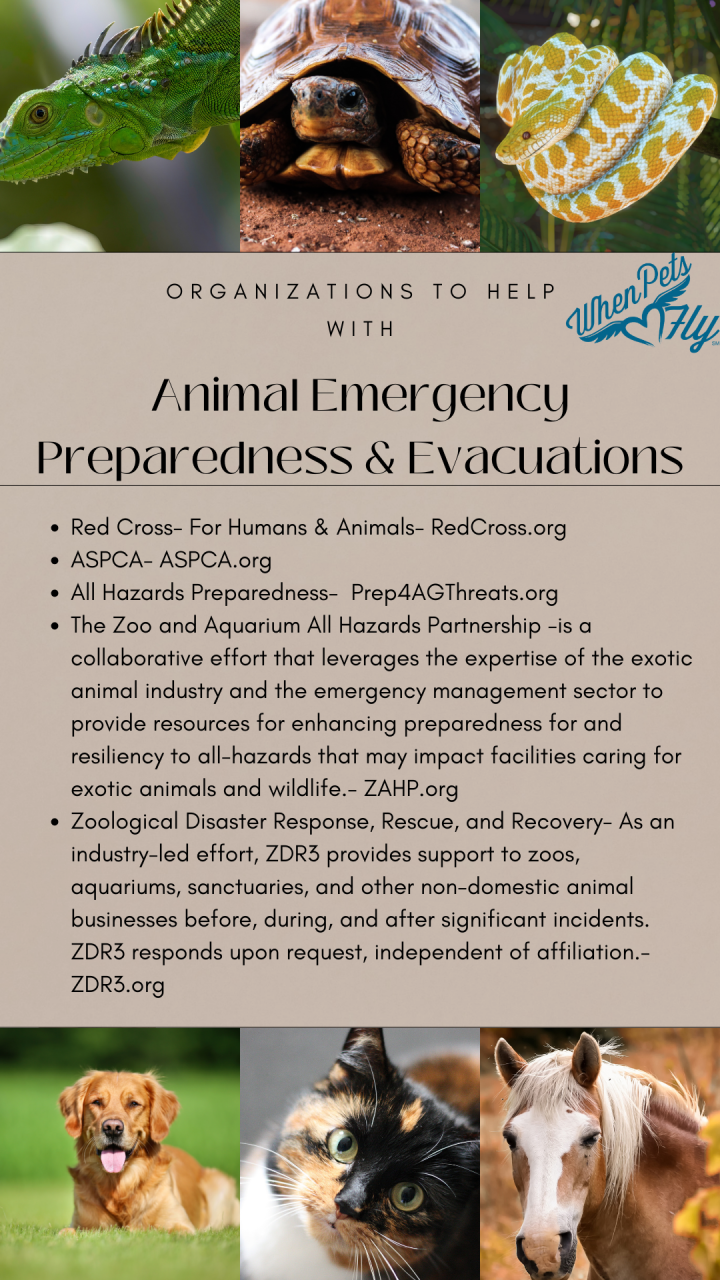Animal Emergency Preparedness and Evacuation Planning
There are several natural disaster seasons that are scary and dangerous for man and beasts. But as long as we make plans and prepare for them, we all can make it to safety. Whether you live in an area that is prone to floods, fire, hurricanes or tornados, 1) create an Emergency Kit, 2) Make a plan of Evacuation and 3) Be Informed as to what is available to you and the animals that you are rescuing.
As the leader in rescuing operations, we researched the Red Cross and looked for some answers from them that we could share about animal emergency preparedness and evacuation planning. Here are some of the things they mentioned…
There is a chance of 12 to 17 named storms this year, according to the National Oceanic and Atmospheric Administration (NOAA) predictions for the 2023 Atlantic hurricane season which officially runs from June 1 to November 30. Five to nine storms could become hurricanes and we usually see them in August, September and the beginning of October. Decide how to best protect your home from high winds and flooding. Plan how you will evacuate and how you will shelter safely at home. Take three important steps ─ get a kit, make a plan and be informed. American Red Cross has information and steps for Older Adults, People with Disabilities and Pets.
The Red Cross encourages people to develop emergency preparedness plans for themselves and their pets. When possible, Red Cross shelter workers will do all they can to accommodate domesticated pets comfortably, however, depending on the situation, pets may need to be housed in a different location. Service animals that assist people with disabilities are allowed in Red Cross shelters.
Create a pet emergency kit ─ place the following items in a sturdy, easy-to-carry container:
- Sturdy leashes, harnesses and/or carriers to transport pets safely and ensure that they can't escape.
- Food, drinking water, bowls, cat litter/pan and a manual can opener if your pet eats canned food.
- Medications and copies of medical records stored in a waterproof container.
- A first aid kit.
- Current photos of you with your pet(s) in case they get lost. Since many pets look alike, this will help to eliminate mistaken identity and confusion.
- Information on feeding schedules, medical conditions, behavior problems, and the name and number of your veterinarian in case you have to foster or board your pets.
- Pet beds and toys, if easily transportable.
Create a pet emergency plan:
- Know which hotels and motels along your evacuation route will accept pets in an emergency. Call ahead for reservations if you know you may need to evacuate. Ask if no-pet policies could be waived in an emergency.
- Know which friends, relatives, boarding facilities, animal shelters or veterinarians can care for your animals in an emergency. Prepare a list of phone numbers.
- Include your pets in evacuation drills so that they become used to entering and traveling in their carriers calmly.
- Make sure that your pet's vaccinations are current and that all dogs and cats are wearing collars with securely fastened up-to-date identification.
- Consider having your pet "microchipped" by your veterinarian.
Be Informed:
Download the free Red Cross First Aid app so you'll know what to do if emergency help is delayed and the free Emergency app for weather alerts, open Red Cross shelter locations and safety steps for different emergencies. Pet owners can download the Red Cross Pet First Aid app for more information on how to include pets in emergency preparedness plans and step-by-step instructions for first aid emergencies and more." As mentioned on the Red Cross site.
The Red Cross recommends that all human first aid kits for a family of four include the following:
- 2 absorbent compress dressings (5 x 9 inches)
- 25 adhesive bandages (assorted sizes), also found within our Family First Aid Kit
- 1 adhesive cloth tape (10 yards x 1 inch)
- 5 antibiotic ointment packets (approximately 1 gram)
- 5 antiseptic wipe packets
- 2 packets of aspirin (81 mg each)
- 1 emergency blanket
- 1 breathing barrier (with one-way valve)
- 1 instant cold compress
- 2 pair of nonlatex gloves (size: large)
- 2 hydrocortisone ointment packets (approximately 1 gram each)
- 1 3 in. gauze roll (roller) bandage
- 1 roller bandage (4 inches wide)
- 5 3 in. x 3 in. sterile gauze pads
- 5 sterile gauze pads (4 x 4 inches)
- Oral thermometer (non-mercury/nonglass)
- 2 triangular bandages
- Tweezers
- Emergency First Aid instructions
Pet Disaster Preparedness
Learn how to prepare your pets for an emergency evacuation and help them recover afterward.
In an emergency, your pets will be even more dependent on you for their safety and well-being. Your family's disaster plans must include your furry family members too. Learn what to do to keep your beloved pets safe!
This guide is primarily about dogs and cats. For tips on disaster planning for livestock, horses, birds, reptiles, or small animals such as gerbils and hamsters, please visit The Humane Society of the United States or Ready.gov.
Keep Livestock and Companion Animals Safe:
Consider a precautionary evacuation of your animals, especially any large or numerous animals. Waiting until the last minute could be fatal for them and dangerous for you.
- Where possible, move livestock to higher ground. If using a horse or other trailer to evacuate your animals, move sooner rather than later.
- Bring your companion animals indoors and maintain direct control of them. Be sure that your pet emergency kit is ready to go in case of evacuation.
Helping Pets Recover
Your pet's behavior may change dramatically after a disaster, becoming aggressive or defensive. Be aware of their wellbeing and protect them from hazards to ensure the safety of other people and animals.
- Watch your animals closely and keep them under your direct control as fences and gates may have been damaged.
- Pets may become disoriented, particularly if the disaster has affected scent markers that normally allow them to find their home.
- Be aware of hazards at nose and paw or hoof level, particularly debris, spilled chemicals, fertilizers and other substances that might not seem to be dangerous to humans.
- Consult your veterinarian if any behavior problems persist.
Other helpful resources are found in this flier that can help with animals in zoos as well as preparing for reptiles and exotic animals.
Sign up for travel news, updated regulations and advice to followers in our next Newsletter



